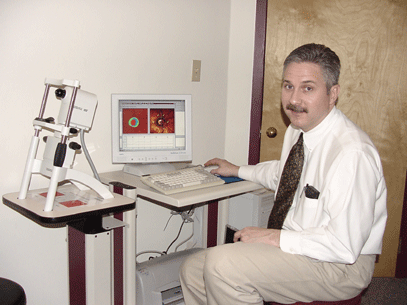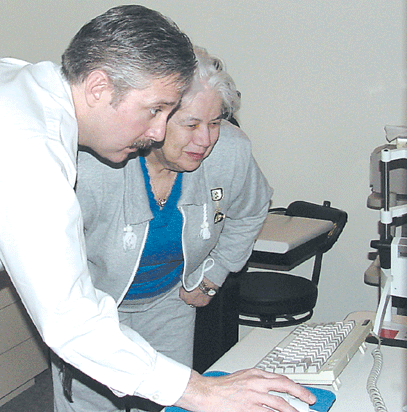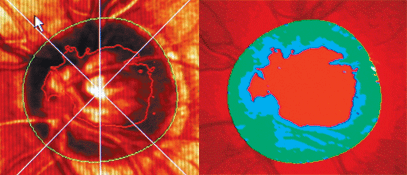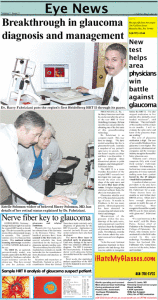Eye News Volume I Issue 5

Breakthrough in glaucoma diagnosis and management

New test helps area physicians win battle against glaucoma
PHOENIXVILLE, PA, _ Dr. Barry Fabriziani can’t hide his excitement after the arrival of the new HRT II from Heidelberg, Germany. He beat out other eye care providers by obtaining one of the first units of this groundbreaking technology.
Dr. Fabriziani is no computer expert. This may have to change. “We have needed something like this in glaucoma for years. I can take a snapshot of my patient’s optic nerve in seconds. The test doesn’t require eye drops and there is no discomfort. I get a detailed three dimensional picture to guide diagnosis and management”, Fabriziani claims.
The HRT II is a more friendly descendent of the original HRT research tool developed ten years ago. It records the exact size and shape of the optic nerve and the nerve fiber layer of the retina. Complex imaging and statistical software helps the physician treat glaucoma.
Glaucoma attacks over 15% of the population past the age of sixty. It results in blindness in far too many patients. Advanced glaucoma has been detected in unsuspecting individuals in the forties and younger.
Measurement of the pressure within the eye, drawings of the optic nerve, and computerized visual field tests have been the foundation of glaucoma management for years. Nevertheless, even the best doctors admit they miss some cases and over diagnose others.
“In the first week I initiated glaucoma treatment in three patients who had damage that was too subtle to recognize before the HRT II. I’ve also stopped medication in five patients who, probably, never needed treatment”, said Fabriziani. “The real benefit of this machine will be evident in six months. I will re-evaluate the optic nerve and know if the glaucoma drops are working.”
The cost of glaucoma medication is high. The cost of preventable blindness from glaucoma is even higher. The government, pharmaceutical companies and the insurance industry recognize the need for better glaucoma care.
“Patients can’t always cooperate fully with visual field testing”, Fabriziani continues. “It is frustrating. A bad test may mean worsening glaucoma or it may represent nothing more than a patient bored by the 45 minute visual field examination.”
A number of other eye care providers in the area have started to send their patients to Dr. Fabriziani for a scan. “Some doctors have six months to wait before their HRT II arrives. Others don’t have enough glaucoma patients to justify the cost of the technology. Most recognize the need for a yearly HRT II scan for their patients with glaucoma”, Fabriziani adds.
“I’ve seen him twice in the last week”, said Dr. Maria Parisi, former chief of Pediatrics at the Pennsylvania College of Optometry. Dr. Parisi, who remains active academically in the field is also excited by this new technology. Nevertheless, she hopes her husband (Dr. Fabriziani) will, “come home soon to visit the twins, Joshua and Jonathan.”

Nerve fiber key to glaucoma
HEIDELBERG, Germany _ Orange-red laser light was used in the original HRT nearly a decade ago. This device scans the eye and creates three-dimensional images in seconds. The “picture” contains sixty-five thousand data points. This confocal retinal scanning microscope resembles a CAT-SCANNER dedicated to the eye.
The HRT II, an updated, patient-friendly model, was recently approved by the FDA and validated by Medicare and other major insurance carriers for clinical use. They have covered its cost for patients with glaucoma and related conditions.
Phoenixville Eye Associates has obtained one of the first units in the Delaware Valley. One hundred patients have been scanned in the first week and a special schedule has been established for the backlog of glaucoma patients needing care. The extraordinary benefits of this machine have created a six month backorder for the manufacturer from physicians and practices in the US.
Scientists and researchers at Moorfields, England as well as contributors from the United States have made extremely early diagnosis of glaucoma by the HRT II possible. Application to macular (retinal) disease and ocular melanoma have also been developed.
The nerve fiber layer is attacked early in glaucoma. Until now, damage to the nerve fiber was extremely difficult to diagnose. The HRT II measures this layer precisely. It helps the doctor verify glaucoma before irreversible loss of the visual field occurs.
Next week, the statistical analysis capabilities of the HRT II will be featured in next week’s Eye News.
Sample HRT II analysis of glaucoma suspect patient.

| Stereometric Results | ONH 0 – 360 |
| Disk Area: | 1.456 mm |
| Cup Area: | 0.241 mm |
| Cup/Disk Area Ratio: | 0.170 |
| Rim Area: | 1.175 mm |
| Height Variation Contour: | 0.338 mm |
| Cup Volume: | 0.044 cmm |
| Rim Volume: | 0.304 cmm |
| Mean Cup Depth: | 0.167 mm |
| Maximum Cup Depth: | 0.688 mm |
| Cup Shape Measure: | 0.364 |
| Mean RNFL Thickness: | 0.243 mm |
| RNFL Cross Section Area: | 1.026 mm |
| Classification: | Normal (2.69) |

Dr. James Lewis has multiple years’ experience treating Philadelphia and Bucks County laser eye surgery patients. In addition to his LASIK expertise, Dr. Lewis is also renowned throughout the greater Philadelphia as an accomplished, compassionate Epi-LASIK Philadelphia expert. For individuals who desire to achieve freedom from glasses but cannot undergo LASIK, he offers Visian ICLs in Bucks County / Philadelphia.